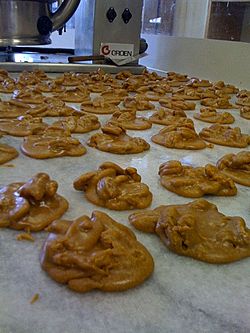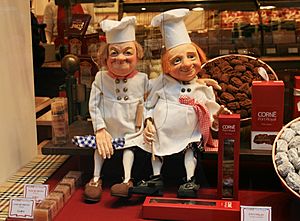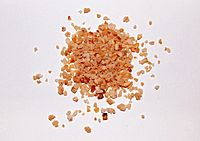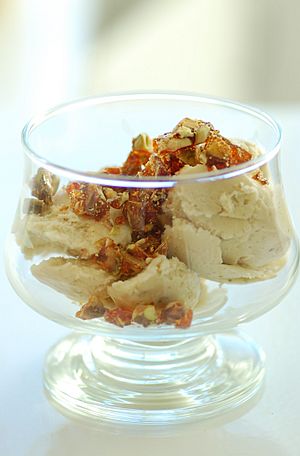Praline facts for kids

Freshly scooped American creamy pralines cooling on a marble slab; European pralines lack the cream
|
|
| Type | Confectionery |
|---|---|
| Place of origin | France |
| Main ingredients | Chocolate, nuts, syrup |
Praline is a sweet treat made from nuts and sugar syrup. It can be a whole piece of candy or a ground powder. When it's a powder, it's called "pralin."
There are different kinds of pralines around the world. For example, Belgian pralines are usually chocolates with a hard shell and a soft, creamy filling. French pralines are made with almonds and caramelized sugar. In the U.S., American pralines are softer and creamier, often made with milk or cream, similar to fudge.
Contents
What Are the Main Types of Pralines?
Pralines come in a few main types, each with its own special taste and texture. These differences depend on where they are made and what ingredients are used.
European Nut Pralines

The idea for praline might have started in France. It's said that a cook for Marshal du Plessis-Praslin (who lived from 1598–1675) created the first ones. The word praline comes from his name, Praslin.
Early pralines were whole almonds, each covered in caramelized sugar. This was different from dark nougat, where many nuts are covered together in a sheet of sugar. At that time, chocolate from the New World was not yet part of the praline recipe. European chefs used nuts like almonds and hazelnuts that were common in their region.
Pralin and Praliné
When these caramel-coated nuts are ground into a powder, it's called pralin. This powder is used in many cakes, pastries, and ice creams.
If this pralin powder is mixed with chocolate, it becomes praliné in French. This is what led to chocolat praliné, which are chocolates filled with this delicious mixture. In many parts of Europe, the word praline often means this nut powder or the chocolate paste made from it. It's widely used to fill chocolates. So, in places like Germany, the Netherlands, Belgium, and the United Kingdom, "praline" can mean filled chocolates in general.
Belgian Soft-Centre Pralines
Belgian pralines are also known as "soft-center Belgian chocolates" or "chocolate bonbons." These are chocolate cases, usually made from high-quality Belgian chocolate, filled with a soft center.
History of Belgian Pralines
The first Belgian pralines were created by Jean Neuhaus II, a Belgian chocolatier, in 1912. Since then, many types and shapes have been made. They almost always have a chocolate shell with a softer filling inside.
What's Inside Belgian Pralines?
The word "praline" in Belgium can be a bit confusing. It can mean filled chocolates in general. It can also refer to a traditional praline filling. This filling is made from caramelized hazelnuts or almonds ground into a paste. Sometimes, it includes whey powder, condensed milk, or cream.
Belgian chocolates are not limited to this traditional filling. They often include other tasty things like nuts, marzipan, salted caramel, coffee, spirits, cream liqueur, cherry, or a chocolate blend that tastes different from the outer shell. These chocolates are often sold in fancy gift boxes. Some of the biggest makers are Neuhaus, Godiva, Leonidas, and Guylian.
American Cream-Based Pralines
French settlers brought the praline recipe to Louisiana. This area was perfect for making pralines because it had lots of sugar cane and pecan trees.
How American Pralines Were Made
During the 1800s, chefs in New Orleans changed the recipe. They used pecans instead of almonds. They also added cream to make the candy thicker. This is how the American praline, famous throughout the American South, was created.
American pralines have a creamy texture, much like fudge. They are usually made by mixing sugar (often brown sugar), butter, cream or buttermilk, and pecans. These ingredients are cooked in a pot over medium-high heat. The mixture is stirred constantly until most of the water has evaporated. It becomes thick and turns a brown color.
Then, spoonfuls of the mixture are dropped onto wax paper or buttered aluminum foil. They are left to cool and harden.
Pralines in Popular Culture
"Pralines and Cream" is a very popular ice cream flavor in the United States and Canada. In New Orleans, Acadiana, and Baton Rouge, Louisiana, pralines are sometimes called "pecan candy."



